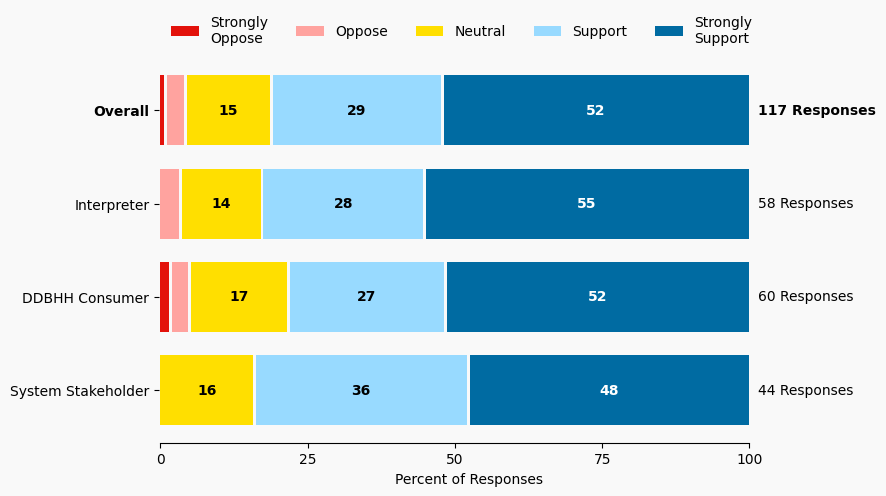96 Recruit to Interpreter Training Programs (ITPs) via Student Loan Forgiveness
Issue: Often, people are opting out of college programs due to high student loan debt that may be incurred.
Proposed Solution: Coalition explore student loan forgiveness programs. If there are no programs that ITP graduates could use, begin a process to advocate for student loan forgiveness at the state and/or federal level.
Expected outcome: More ITP students enrolled because of ficial supports that allow for student loan forgiveness.
Who is impacted: Prospective students
Timeline: 6 months

Summary of Support Image Description
The stacked bar charts show how respondents rated their level of support and the total number of responses. The percentage for the five support levels is shown from left to right: Strongly Oppose (Dark Red), Oppose (Light Red), Neutral (Yellow), Support (Light Blue), and Strongly Support (Dark Blue).
Respondents may identify with multiple subgroups. The overall level of support is:
Overall
Strongly Oppose: 1%
Oppose: 3%
Neutral: 15%
Support: 28%
Strongly Support: 52%
Click to see the detailed image description for each subgroup.
Interpreter
Strongly Oppose: 0%
Oppose: 3%
Neutral: 14%
Support: 28%
Strongly Support: 55%
Non-Certified Interpreter
Strongly Oppose: 0%
Oppose: 9%
Neutral: 27%
Support: 9%
Strongly Support: 55%
DDBHH Consumer
Strongly Oppose: 2%
Oppose: 3%
Neutral: 17%
Support: 27%
Strongly Support: 52%
Interpreter Training Program
Strongly Oppose: 0%
Oppose: 0%
Neutral: 10%
Support: 30%
Strongly Support: 60%
System Stakeholder
Strongly Oppose: 0%
Oppose: 0%
Neutral: 16%
Support: 36%
Strongly Support: 48%
Overview of Respondents Opting for In-Depth Solution Analysis
After indicating their support level, 4% of the 117 respondents opted in to further assess whether the solution would worsen or improve on five metrics. Of the opt-in reviewers (5 respondents), 100% supported the solution, 0% were neutral on the solution, and 0% opposed the solution.
The remaining 112 respondents did not opt in to further assess the solution. Of these people, 80% support the solution, 15% were neutral on the solution, and 4% opposed the solution.
Reviewer Evaluation of Solution Effectiveness

Solution Effectiveness Image Description
The stacked bar charts show how respondents assessed the effectiveness of this solution based on five metrics. For each metric, the percentage of respondents is shown from left to right: Worsens (Red), Improves (Blue), No Impact (Gray).
DDBHH Quality of Life
Makes It Worse 0%
Makes It Better 100%
No Impact 0%
Interpreter Satisfaction
Makes It Worse 0%
Makes It Better 100%
No Impact 0%
Consumer Choice
Makes It Worse 0%
Makes It Better 100%
No Impact 0%
Interpreting Availability
Makes It Worse 0%
Makes It Better 100%
No Impact 0%
Interpreting Quality
Makes It Worse 0%
Makes It Better 100%
No Impact 0%
Reviewer Feedback and Insights
Interpreter
Comments from Interpreters support the idea of loan forgiveness and suggest that the program should apply to those providing services in underserved communities. Another comment suggests exploring whether interpreting could qualify under the current Public Service Loan Forgiveness program.
Deaf, DeafBlind, Hard of Hearing
Comments from DDBHH Consumers support loan forgiveness as a way to attract more people to the interpreting field and suggest expanding the program to include graduate tuition and personal loans for education.
System Stakeholder
Comments from System stakeholders echo support for loan forgiveness as an effective way to recruit more interpreters into the field.
PREVIOUS SOLUTION
95 Develop Publicly Funded Scholarships for ITPs
Issue: Interpreter shortage
NEXT SOLUTION
97 Advertise Interpreting in MN is an Attractive Career: Short Advertising Videos
Issue: Interpreter shortage
Leave a Reply